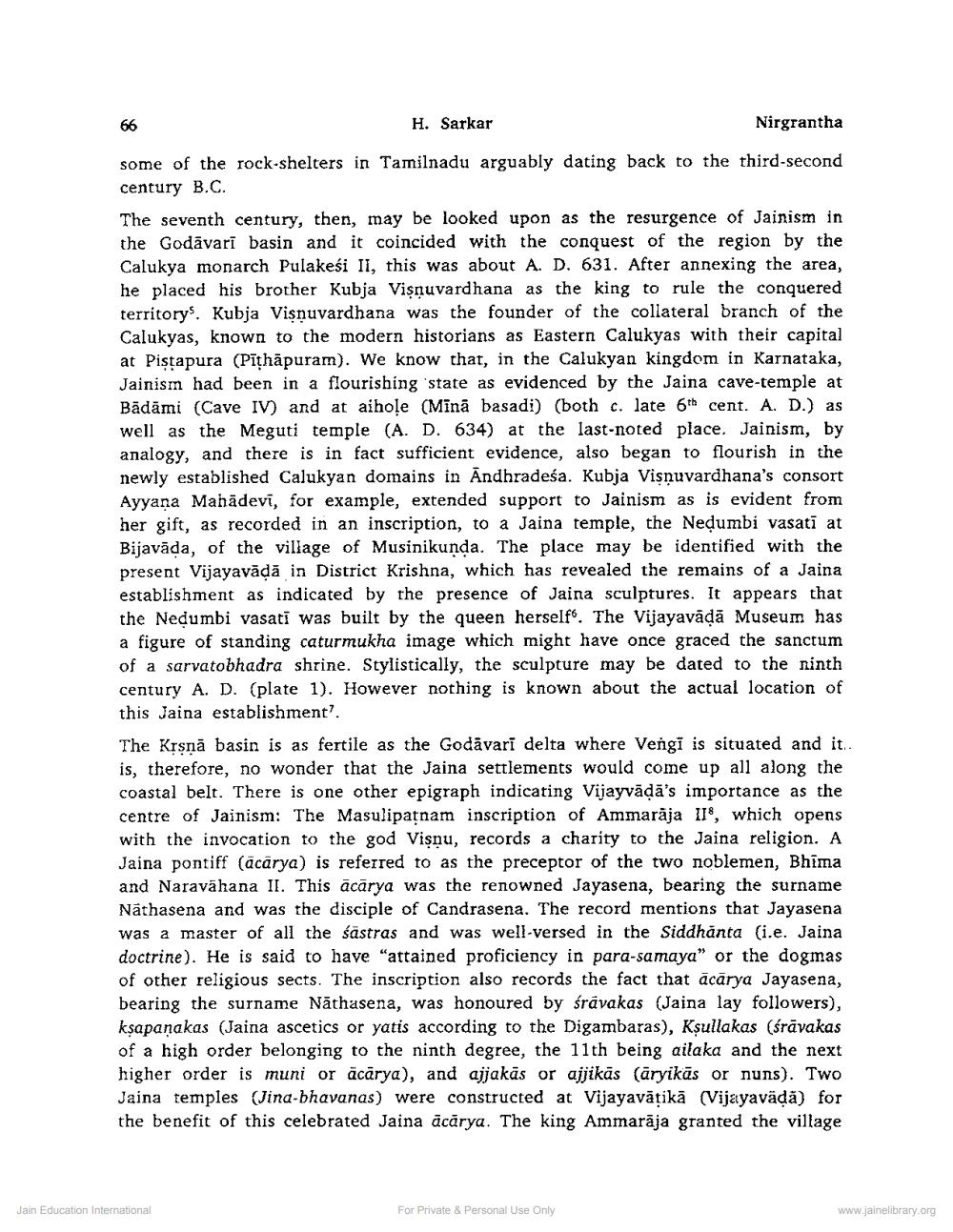Book Title: Glimpses of Jaina Vestiges in Andhradesa Author(s): H Sarkar Publisher: Z_Nirgrantha_1_022701.pdf and Nirgrantha_2_022702.pdf and Nirgrantha_3_022703.pdf View full book textPage 2
________________ 66 H. Sarkar Nirgrantha some of the rock-shelters in Tamilnadu arguably dating back to the third-second century B.C. The seventh century, then, may be looked upon as the resurgence of Jainism in the Godavari basin and it coincided with the conquest of the region by the Calukya monarch Pulakeśi II, this was about A. D. 631. After annexing the area, he placed his brother Kubja Visnuvardhana as the king to rule the conquered territory. Kubja Visnuvardhana was the founder of the collateral branch of the Calukyas, known to the modern historians as Eastern Calukyas with their capital at Pistapura (Pithapuram). We know that, in the Calukyan kingdom in Karnataka, Jainism had been in a flourishing state as evidenced by the Jaina cave-temple at Bādāmi (Cave IV) and at aihole (Mīnā basadi) (both c. late 6th cent. A. D.) as well as the Meguti temple (A. D. 634) at the last-noted place. Jainism, by analogy, and there is in fact sufficient evidence, also began to flourish in the newly established Calukyan domains in Andhradeśa. Kubja Visnuvardhana's consort Ayyana Mahadevi, for example, extended support to Jainism as is evident from her gift, as recorded in an inscription, to a Jaina temple, the Nedumbi vasati at Bijavāda, of the village of Musinikunda. The place may be identified with the present Vijayavāḍā in District Krishna, which has revealed the remains of a Jaina establishment as indicated by the presence of Jaina sculptures. It appears that the Nedumbi vasati was built by the queen herself". The Vijayavāḍā Museum has a figure of standing caturmukha image which might have once graced the sanctum of a sarvatobhadra shrine. Stylistically, the sculpture may be dated to the ninth century A. D. (plate 1). However nothing is known about the actual location of this Jaina establishment'. The Kṛṣṇā basin is as fertile as the Godavari delta where Vengi is situated and it is, therefore, no wonder that the Jaina settlements would come up all along the coastal belt. There is one other epigraph indicating Vijayväḍā's importance as the centre of Jainism: The Masulipatnam inscription of Ammaraja II', which opens with the invocation to the god Visņu, records a charity to the Jaina religion. A Jaina pontiff (ācārya) is referred to as the preceptor of the two noblemen, Bhima and Naravahana II. This ācārya was the renowned Jayasena, bearing the surname Näthasena and was the disciple of Candrasena. The record mentions that Jayasena was a master of all the śästras and was well-versed in the Siddhanta (i.e. Jaina doctrine). He is said to have "attained proficiency in para-samaya" or the dogmas of other religious sects. The inscription also records the fact that ācārya Jayasena, bearing the surname Nathasena, was honoured by śravakas (Jaina lay followers), kṣapaṇakas (Jaina ascetics or yatis according to the Digambaras), Kṣullakas (śrāvakas of a high order belonging to the ninth degree, the 11th being ailaka and the next higher order is muni or acarya), and ajjakās or ajjikās (āryikās or nuns). Two Jaina temples (Jina-bhavanas) were constructed at Vijayavātikā (Vijayavāḍā) for the benefit of this celebrated Jaina ācārya. The king Ammaraja granted the village Jain Education International For Private & Personal Use Only www.jainelibrary.orgPage Navigation
1 2 3 4 5 6 7 8
